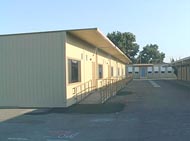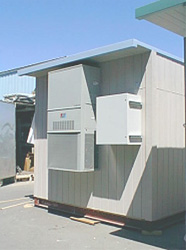|
Approximately two million children in California attend school in relocatable
classrooms, also known as portables. Are these buildings as environmentally
healthy and energy-efficient as they can be? Berkeley Lab scientists recently
tested an experimental ventilation system that would improve indoor air
quality in portable classrooms and use a third of the energy of current
systems.
|
 |
 |
|
|
 |
Relocatable classrooms in Modesto,
California |
|
Current HVAC systems are able to provide the 15 cubic feet per second
of ventilation required in classrooms by law, but at a high energy cost,
and only if the fan is turned on manually. Many portable classrooms are
not being adequately ventilated, and there would be a significant impact
on peak-hour energy use and the California power grid if current HVAC
systems were operated continuously. A ventilation system tested by Environmental
Energy Technologies Division researchers could solve those problems.
"Contrary to common belief," said Mike Apte, principal investigator,
"you can design buildings that use less energy and address indoor
air quality issues, if you do it right and are clever about it."
Clever ways to reduce energy consumption is one of the things EETD researchers
do best. This work was done by Apte and his colleagues William Fisk, Alfred
Hodgson, Richard Diamond, Dennis DiBartolomeo, Tosh Hotchi, Satish Kumar,
Seung Min Lee, Shawna Liff, Leo Rainer, Marion Russell, Derek Shendell
and Doug Sullivan. It was funded by the California Energy Commission.
Also collaborating on the project were the Davis Energy Group, an innovator
in heating and cooling technologies, two school districts, and AMS, Northern
California's largest manufacturer of portable classrooms.
About one-third of all classrooms in the state are in portable buildings.
This number continues to go up as California's population increases and
school districts attempt to reduce class sizes. The classrooms have gained
a reputation for bad indoor air quality, especially for high levels of
volatile organic chemicals, or VOCs. The Berkeley Lab study set out to
evaluate the benefits of an experimental building ventilation system and
construction materials that emit fewer indoor pollutants.
The school districts -- hot Modesto and moderate Cupertino -- had each
already decided to buy two new 24 foot by 40 foot classrooms. They agreed
to have one standard classroom as a control, and one experimental classroom,
finished with alternative low-emission carpets, wall panels and ceiling
panels. Both standard and experimental buildings were constructed with
energy-efficient lighting, windows, and insulation levels.
Each building also had two HVAC systems: a standard electric compressor-based
air conditioner/heat pump, and an indirect-direct evaporative cooler,
or IDEC. The standard heat pump is controlled by a thermostat and outdoor
air is only supplied when the heat pump is either heating or cooling the
air, or when the fan is turned on manually. Compared against newer heat-pump
systems available on the market, many of these units have a relatively
low seasonal energy efficiency ratio (SEER) rating, a measure of energy
efficiency. They also have a reputation for being noisy.
The IDEC operates through the evaporation of water, but employs a heat
exchanger to separate most of the water from the ventilation supply air.
It provides continuous ventilation with fresh outside air, is much quieter,
and uses up to 70 percent less energy than the standard HVAC. Apte and
his colleagues also added a gas-hydronic heating system and an improved
filtration system. The IDEC, developed by Davis Energy Group under contract
from the California Energy Commission, is not currently commercially available
for small buildings.
The four portables were delivered in August 2001. Air quality and comfort
levels were monitored for nine weeks of hot weather in the fall and nine
weeks of cold weather in the winter. The HVAC and the IDEC were operated
on alternate weeks during the test periods. Researchers then compared
the energy use and indoor environmental conditions for the two systems.
The researchers did not find that the building materials used gave off
harmful levels of VOCs; the levels in both the standard and alternative-materials
classrooms were very low. Apte says that although the control classrooms
were furnished with standard available materials, other manufacturers
could use different materials that have higher emissions.
|
 |
 |
|
|
| When it comes to reducing volatile
organic chemicals indoors, continuous ventilation appears to be more
important that alternative building materials. |
|
|
What they did find is that continuous ventilation was a much more important
factor for reducing indoor VOC levels than the alternative building materials
that were selected.
Both the HVAC and the IDEC kept the classrooms heated and cooled, but
the energy efficient classroom with the IDEC HVAC system required only
25 million btu/year, according to the DOE-2 computer model ?? about a
third of the energy used by the currently sold standard portable with
heat pump, which underventilates the classroom.
The IDEC also provided greatly improved ventilation when it was operating,
during both the cooling and heating seasons, as measured by classroom
carbon dioxide concentrations.
The study illustrated the added burden an inefficient ventilation system
can place on teachers who, already busy with instructing, grading and
maintaining order, often forgot or neglected to turn on the HVAC. Also,
they found it difficult to teach over the noise of the standard HVAC at
times and preferred to suffer in a hot, cold, or stuffy room rather than
compete with the sound of the fan.
"Controlling the environment comes very low on the list of things
a teacher has to do," said Apte.
Late in the study the researchers installed an occupant sensor that activated
the ventilation system whenever there was someone in the building. That
solution could help improve air quality and take the pressure off busy
educators.
There is still more number crunching and modeling to be done on the collected
data, but the researchers have big plans. Next steps include outreach
to help schools make choices about equipment and materials, and collaboration
with a number of groups developing better classrooms. Apte also wants
to study health and productivity in classrooms, and work with HVAC manufacturers
to find a way to retrofit existing buildings for continuous ventilation
without increased energy usage.
This project is part of a larger plan to design high-performance portable
classrooms that use less energy and provide a better indoor environment
than models currently available.
"I think we can contribute a lot to that with what we've learned,"
said Apte.
Apte and his colleagues presented their research at the Indoor Air 2002
conference in Monterey this July.
|

